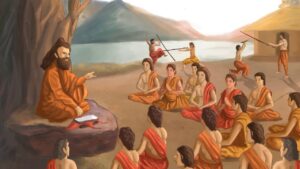
“The highest function of education is to bring about an integrated individual who is capable of dealing with life as a whole.” This quote by renowned philosopher Jiddhu Krishnamurti epitomizes the aim of education in every time period irrespective of its cultural milieu. It points to a teaching-learning process that involves manipulation of stimuli (by the teacher) from an array of disciplines to create a setting that triggers the mind (intellectual), body(physical) and spirit (emotional) of the learner. A multi-dimensional, multi-disciplinary and multi-sensory approach of this kind will set the learner on a meaningful journey of explorations and equip each one of them to deal with the complexities of life in many easy ways.
Ancient Indian education system was built on a foundation of such holistic learning practices and the institutions that led the way in this sphere were the ‘Gurukuls.’ Gurukuls were the learning centers that came up during the Vedic period (1500 BCE-600 BCE). Values such as humility, truthfulness, discipline, self-reliance, and respect for all creations formed the core of this Gurukul system of education. Here, through intellectual interactions and age-appropriate practices, the learner learnt to appreciate and maintain the balance between human beings and nature- a mindful co-existence of both. The Vedas and the Upanishads mention the presence of ‘Gurukul’ or ‘Gurukulams’ where great rulers like the Pandavas, Kauravas, Lord Rama and Lord Krishna are believed to have studied. The Upanishad carry references of the Gurukul run by Guru Dronacharya.
Guru(teacher)-Shishya (student) Parampara (tradition) remained the cornerstone of this system of education. The word Gurukul literally means ‘family’ (kula) of the ‘teacher’ (Guru) and hence the name. The Shishya lived with the guru as part of his family. The teacher or the Acharya, the student or the Shishya, the place where the guru and the Shishya interacted- the Ashram were the pillars on which the Gurukuls rested. The ambience of this Ashram was of utmost importance. It was nestled in the lap of nature away from the humdrum of everyday life. The objective here was to remove all worldly distractions that would otherwise hinder the growth of a balanced approach and analytical vision in the young evolving minds. Now, at this point it won’t be wrong to classify this institution as ‘different’ but the question remains “What exactly sets them apart?

The curriculum and pedagogy established by the Gurus were one of its kind making the Gurukuls a nucleus of holistic learning. “Experience (Anubhava) was the best teacher”was one of its main philosophies. Hence, the methodology revolved around the Shishyas getting hands-on experience. Unlike the contemporary education system where the main source of learning is the textbook Gurukuls emphasized on attaining knowledge from various sources which included the holy texts like Vedas, Upanishads, Dharmasutras and Brahmanas. History, logic, interpretation, science, architecture, trade, commerce, polity, agriculture etc. were the other fields from which the Shishyas gained knowledge. Physical Education was a major subject with the Shishyas engaging in krida (games, recreational activities), Vyayamaprakara (exercises), Dhanurvidya (archery) for acquiring martial skills, and Yogasadhana (training the mind and body) among others. The Guru’s learning and experiences were never discounted but were a part of the curriculum. The Gurus and their Shishyas worked together as a family to attain the desired level of proficiency of the Shishyas in all aspects of learning. “Acharya Upanayamano Brahmacarinam Karute Garbha-mantaha” ( Acharya protects the Shishya just like a pregnant woman protects the child in her womb). This text from the Atharva Ved best exemplifies the spirit of a family in a gurukul.
A typical day in the Ashram would start very early by the sunrise with the Shishyas engaging in cooking, cleaning, followed by chanting of mantras, physical fitness, interactive classes, ‘Madhukari’ or begging for alms for daily sustenance, rest and then resume classes till dusk. In this grueling day of the Shishyas where did the Guru place himself? The Guru was central in this system of education. He was the Facilitator. The Guru played a key role in confidence building. The confidence he instilled in his Shishyas complemented their education and experience. The words of the Guru had creative powers. The Chandogya Upanishad attributes the guru to be the spark which creates the right understanding in his Shishyas. The guru’s individual instruction and attention triggered the mental faculties of his Shishyas. That’s how the Guru tapped into the latent and innate capacities of his Shishyas. He regarded making of a man as an artistic process and not a mechanical one. Education was therefore tailored to meet the individual needs of the Shishyas in the Gurukuls. Analytical and critical thinking, knowledge application, memory etc. of the Shishyas were constantly tested by the gurus. When the guru was satisfied with the performance of his Shishya, the course for him ended. Hence, this system did not produce mass graduates like today.
One can ask “What’s the problem in producing mass graduates today especially in a country like ours with such a large population?” Agreed India does need more and more educated people to cater to the growing industries. The problem lies neither in population nor industries. The problem lies in the present education system which is producing unprepared individuals devoid of any significant exposure of any sort. This system only revolves around ‘marks obtained’ and ‘admission gained’ culture which does not excite the physical, emotional, or intellectual capacities of the individual in the right manner. In the contemporary teaching-learning process across schools in India the Gurus or the teachers no longer have an active role in their students’ lives. They have turned into translators translating the language of the textbook for their students. The students and teachers are trapped in a never-ending cycle of test papers, exams, and marks- the exact point where holistic learning lost its meaning. Making the matter worse is the exorbitant fee structures charged by these institutions making ‘Right to Education’ accessible only to the few. Do we say more?

Bincy Thomas
Bincy was a teacher by profession but now, is a history buff by choice. Being a fitness enthusiast with a keen interest for trekking, she combines this interest with history and sets out exploring lost and forgotten monuments, to gather new insights and information. When she’s not trekking, yoga, meditation and reading takes away her time.

